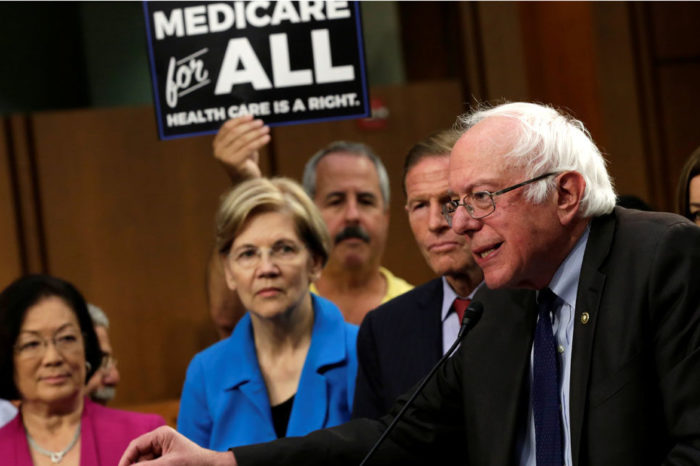Empathy is fostered in a culture where commercial transactions occur between all walks of life.
You’ve probably heard this story before: a terrible crime occurs, the press interviews the neighbors of the perpetrator, and the neighbors say they never saw it coming.
Consider Robert Bowers, the mass murderer who killed eleven people at the Tree of Life synagogue in Pittsburgh. One neighbor said this:
It’s just so disturbing that someone so normal could have so much hate. You think you know your neighbor, but this just shows how wrong you can be.
Good vs. Evil: More Complicated Than You Think
Some may dismiss such comments as coming from clueless, unobservant individuals. Surely there are signs that individuals, such as Bowers, are capable of committing heinous acts. We are comfortable believing in good guys and bad guys, separated by a relatively impermeable barrier between the polarities. Think of villains in popular movies and television—they are often one-dimensional characters who easily commit terrible acts, often without a rationale.
Renowned psychology professor Roy Baumeister is best known for his work on willpower. His work on the nature of evil deserves close examination, too. He begins his book, Evil: Inside Human Violence and Cruelty, with a bold proposition: “Evil usually enters the world unrecognized by the people who open the door and let it in. Most people who perpetrate evil do not see what they are doing as evil.”
Baumeister defines evil as “actions that intentionally harm other people.” When we have a black and white view of evil, it is easy to believe that those like Bowers must be insane. Not true, Baumeister informs us: “insanity is in fact a relatively rare and minor cause of violence.”
Calling someone “insane” is an attempt to absolve them of responsibility. As Baumeister observes, “People do become extremely upset and abandon self-control, with violent results, but this is not insanity.” He adds, “violence is often an impulsive action representing a failure of self-control—but a failure in which the person often acquiesces.”
Would you, Baumeister asks, “obey orders to kill innocent civilians? Would you help torture someone? Would you stand by passively while the secret police hauled your neighbors off to concentration camps?” Baumeister writes, “Most people say no. But when such events actually happen, the reality is quite different.”
There is No Such Thing as Pure Evil
In his acclaimed work The Gulag Archipelago, Aleksandr Solzhenitsyn observed:
If only there were evil people somewhere insidiously committing evil deeds, and it were necessary only to separate them from the rest of us and destroy them. But the line dividing good and evil cuts through the heart of every human being. And who is willing to destroy a piece of his own heart?
Solzhenitsyn continued by observing that the line between good and evil is permeable:
During the life of any heart this line keeps changing place; sometimes it is squeezed one way by exuberant evil and sometimes it shifts to allow enough space for good to flourish. One and the same human being is, at various ages, under various circumstances, a totally different human being. At times he is close to being a devil, at times to sainthood. But his name doesn’t change, and to that name we ascribe the whole lot, good and evil.
In his book The Better Angels of Our Nature, Professor Steven Pinker echoes Solzhenitsyn and Baumeister: “Humans are not innately good (just as they are not innately evil), but they come equipped with motives that can orient them away from violence and toward cooperation and altruism.”
Pinker reveals the factors that help us choose good over evil:
Empathy (particularly in the sense of sympathetic concern) prompts us to feel the pain of others and to align their interests with our own. Self-control allows us to anticipate the consequences of acting on our impulses and to inhibit them accordingly. The moral sense sanctifies a set of norms and taboos that govern the interactions among people in a culture, sometimes in ways that decrease violence, though often (when the norms are tribal, authoritarian, or puritanical) in ways that increase it. And the faculty of reason allows us to extricate ourselves from our parochial vantage points, to reflect on the ways in which we live our lives, to deduce ways in which we could be better off, and to guide the application of the other better angels of our nature.
Baumeister, Pinker, and Solzhenitsyn are correct: The conditions under which people are prone to tip to their evil side deserve a great deal of study and reflection.
The Personal Responsibility to Choose Good
Many of us hold popular beliefs “that frustration, violent movies, poverty, hot weather, alcohol, and unfair treatment all cause aggression.” Baumeister rejects these theories and asks:
Why isn’t there more evil than there is? … Then why wouldn’t almost every adult in America have committed several murders and dozens of assaults by now? After all, how many adult Americans have not been frustrated? Have not seen violent films? Have not felt poor or suffered from hot weather or so forth?
For Baumeister, the answer is clear:
Most violent impulses are held back by forces inside the person. In a word, self-control prevents a great deal of potential violence. Therefore, regardless of the root causes of violence, the immediate cause is often a breakdown of self-control.
Evil and violence increase when we choose to not restrain ourselves. Baumeister explains:
When evil increases, it does not necessarily mean that the causes of evil have become more powerful or important. Rather, it may mean that the inner controls have become weakened. Or, to put it another way: You do not have to give people reasons to be violent, because they already have plenty of reasons. All you have to do is take away their reasons to restrain themselves. Even a small weakening of self-control might be enough to produce a rise in violence. Evil is always ready and waiting to burst into the world.
Many people believe low self-esteem leads to violent acts. “The evidence shows plainly that this idea is false,” Baumeister explains:
Violent acts follow from high self-esteem, not from low self-esteem. This is true across a broad spectrum of violence, from playground bullying to national tyranny, from domestic abuse to genocide, from warfare to murder and rape. Perpetrators of violence are typically people who think very highly of themselves.
He observes that “people whose self-esteem is high but lack a firm basis in genuine accomplishment are especially prone to be violent, because they are most likely to have their narcissistic bubble burst.”
Many educators praise students regardless of their accomplishments, fueling narcissism. One can wonder where this will lead. As these young narcissists meet the world will they “feel like lashing out at anyone who says [they] are not as great as [they] thought.”
Authoritarians Promote Evil
Both Baumeister and Pinker point to empathy as a factor that brings out our “better angels.” As Baumeister points out, though, human beings tend to feel the most empathy for those who are “most similar to themselves.” In other words, many default to tribalism.
Before his deadly act in Pittsburgh, Bowers blamed Jews for helping to promote immigration. He posted on the social media platform, Gab, “I can’t sit by and watch my people get slaughtered.” “All Jews [must] die” played like a mantra in his mind. If Bowers taps into his capacity for empathy, he extends empathy to a narrowly defined tribe.
Authoritarian societies—whether called socialist, communist, or fascist—are always looking to find scapegoats. In those societies, there is always the “evil other,” a group or groups who have “sabotaged” the greatness of the authoritarian regime. When monstrous evil deeds are committed, some perpetrators assuage their guilt by believing their acts defend their “noble” vision. Others believe they are merely following orders and doing their job.
Reading accounts of Nazi, Soviet, or North Korean concentration camps, remarkable similarities are revealed. Unspeakable brutality is practiced and rationalized. The rationalization always begins with some form of the belief that their victims are not truly human. As Baumeister puts it, “The lack of empathy makes violence toward outsiders easier because it undermines the restraining power of guilt.”
Baumeister relates the story of a man concerned about the lack of food and adequate clothing at a Soviet labor camp in his village. At significant risk to himself, he protested to the camp administrator, “These people might die!” “The camp administrator replied, ‘What people? These are enemies of the people.’”
Capitalism Promotes Goodness
Since I don’t spend hours at a time driving, I recently called SiriusXM to cancel their service; I could not justify the cost. Before making the call, I knew many complain about how hard it is to cancel their subscription. I was also aware that I’d be speaking with an agent at a call center in India. Yet, as the agent took my call, I was feeling empathy. I imagined the agent was being measured on some retention metric and that he frequently interacted with customers who just wanted to get off the phone without hearing his retention pitch.
The person I spoke with was solicitous and concerned. Why wouldn’t he be? His well-being (succeeding at his job) depends on satisfying customers. The need to satisfy customers brings out an empathetic response towards seeing the world from the point of view of the customer. Perhaps he was looking at a computer screen showing him my limited usage stats. Ten minutes and a pleasant chat later, the price of my service was reduced to a win-win, 65 percent off my previous price.
If either of us had no empathy for the other, a lose-lose outcome might have resulted. Empathy greases the wheels of commercial transactions. SiriusXM is rewarded when they hire empathic service agents who can discern consumers’ needs.
Perhaps some readers are cynical of my account. Oh, come on; he probably hates his job and was merely following a script. I doubt it, but even so, the demands of commerce were forcing the agent to join hands with me in creating a win-win trade. In the process, his practice of empathy was being rewarded.
In a Forbes essay, “A Virtuous Cycle,” James Surowiecki observed how capitalism “encouraged universalism over provincialism,…a willingness to make and keep promises—often to strangers and foreigners… [as well as] a sense of individual, rather than group, responsibility.” He explains why under capitalism, trust is not built merely on tribal personal relationships:
Trust had been the product only of a personal relationship—I trust this guy because I know him—rather than a more general assumption upon which you could do business. The real triumph of capitalism in the 19th and 20th centuries was that trust was woven into the basic fabric of everyday business. Buying and selling were no longer about a personal connection. It was now about the virtue of mutual exchange.
Einstein urged that we widen our circle of compassion. In a letter to a father grieving the untimely death of his son, Einstein wrote:
A human being is part of a whole, called by us the “Universe,” a part limited in time and space. He experiences himself, his thoughts and feelings, as something separated from the rest—a kind of optical delusion of his consciousness. This delusion is a kind of prison for us, restricting us to our personal desires and to affection for a few persons nearest us. Our task must be to free ourselves from this prison by widening our circles of compassion to embrace all living creatures and the whole of nature in its beauty.
Compassion Through Commerce
Einstein’s call to action is precisely what commerce does: Our circle of compassion widens through empathetic connections forged through trade. If Bowers had been a patient of the Jewish dentist he murdered, might his opinion of Jews been different?
Had he spent time walking the streets of the Squirrel Hill neighborhood where the synagogue was located, might he have stepped into some Jewish businesses? Had he stopped to shop, perhaps he would have realized that Jews were part of the extended order of which we are all a part. Perhaps his hatred would have been mitigated.To be sure, capitalism will not eliminate hatred; the line between good and evil cuts through “the heart of every human being.” Yet capitalism is pointing us in the right direction. As the extended order gets wider, it creates more opportunities for more people to widen their circle of compassion. As commerce weaves together the lives of people everywhere, the question Solzhenitsyn asked—“who is willing to destroy a piece of his own heart?”—becomes easier to answer.
COLUMN BY

Barry Brownstein is professor emeritus of economics and leadership at the University of Baltimore. He is the author of The Inner-Work of Leadership. To receive Barry’s essays subscribe at Mindset Shifts.
EDITORS NOTE: This column with images is republished with permission.

 Greater risk for frequent marijuana use and problems among young adult marijuana users with a medical marijuana card
Greater risk for frequent marijuana use and problems among young adult marijuana users with a medical marijuana card


























